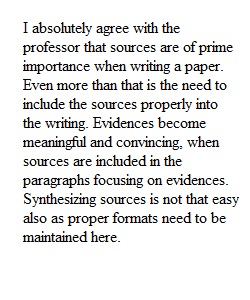


Q Module 4, Unit 5: Synthesizing Sources One of the common problems I see with students doing research and then incorporating their sources into their papers is that there is a tendency to use merely or mostly just one source to provide evidence for a particular point; just staying with that single source to make the point, until moving on to the next point, and then again using just one source to support that idea, etc. This technique is too basic and doesn't demonstrate real, deeper critical thinking. Learning to synthesize sources so that you are part of a conversation about each point you make shows significantly more developed writing and thinking skills. Taking the next step to synthesize is what I'm looking for in college-level research and writing. The tools in this folder should help you understand the concept first and then see it put into practice. In this unit, you will encounter several useful readings/video material that explain and feature synthesis. After having read/watched each of these, read the assigned pages in our textbook to see how synthesis is used in an academic paper. Now, it's your turn! In your discussion board response for this unit, in your first post, you will describe where and how in your paper you plan to feature synthesis. In your second- and third-posts, respond to a couple (one in each post) of your peer's stated plans. Be sure to go beyond, "Sounds good to me!" Be specific in why you think their plan may or may not be best, and suggest or recommend any alternate approach, if needed, that you think might work even better. First post (250 words) due: (see syllabus) Second and third (peer-response) posts (150-200 words each) due: (see syllabus)
View Related Questions